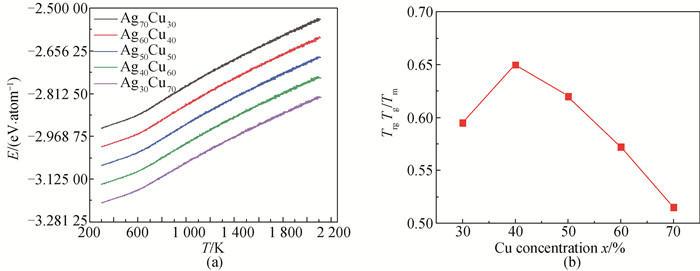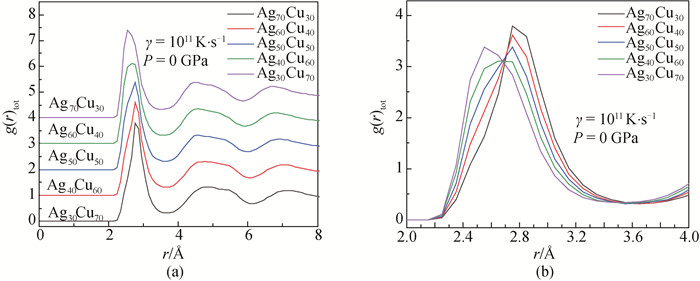Chinese Journal of Computational Physics ›› 2025, Vol. 42 ›› Issue (1): 90-97.DOI: 10.19596/j.cnki.1001-246x.8779
• Research Article • Previous Articles Next Articles
Hengbo TAN1( ), Shuangxiang QI2, Bei CHEN3, Ming GAO1, Dadong WEN1, Tao LIU3, Yonghe DENG1,*(
), Shuangxiang QI2, Bei CHEN3, Ming GAO1, Dadong WEN1, Tao LIU3, Yonghe DENG1,*( )
)
Received:2023-06-12
Online:2025-01-25
Published:2025-03-08
Contact:
Yonghe DENG
Hengbo TAN, Shuangxiang QI, Bei CHEN, Ming GAO, Dadong WEN, Tao LIU, Yonghe DENG. Study of Glass Formation Ability and Evolution of Microstructure of Ag-Cu Alloy[J]. Chinese Journal of Computational Physics, 2025, 42(1): 90-97.
Add to citation manager EndNote|Ris|BibTeX
URL: http://www.cjcp.org.cn/EN/10.19596/j.cnki.1001-246x.8779

Fig.1 Average total atomic energy and reduced glass transition temperature of Ag-Cu alloy (a) variations of average total atomic energy with temperature; (b) variations of reduced glass transition temperature with composition

Fig.2 Two-body distribution functions for different components of Ag-Cu alloy at 300 K (a) total two-body distribution function; (b) first peak amplification of total two-body distribution function
| Cluster index | Ag70Cu30 | Ag60Cu40 | Ag50Cu50 | Ag40Cu60 | Ag30Cu70 |
| (12 12/1551) | 2 630 | 2 824 | 2 811 | 2 419 | 2 065 |
| (12 8/1551 2/1541 2/1431) | 617 | 728 | 732 | 622 | 582 |
| (12 2/1441 8/1551 2/1661) | 688 | 688 | 633 | 674 | 653 |
| (13 1/1441 10/1551 2/1661) | 1 916 | 1 966 | 2 051 | 2 052 | 2 026 |
| (13 3/1441 6/1551 4/1661) | 1 189 | 1 070 | 999 | 1 213 | 1 292 |
| (14 2/1441 8/1551 4/1661) | 1 620 | 1 519 | 1 356 | 1 479 | 1 487 |
| (14 1/1441 10/1551 3/1661) | 940 | 949 | 919 | 814 | 749 |
| (14 3/1441 6/1551 5/1661) | 843 | 661 | 593 | 668 | 846 |
| (15 1/1441 10/1551 4/1661) | 660 | 680 | 744 | 630 | 536 |
| (15 2/1441 8/1551 5/1661) | 809 | 748 | 681 | 669 | 642 |
Table 1 Number of basic clusters in different components of Ag-Cu alloy
| Cluster index | Ag70Cu30 | Ag60Cu40 | Ag50Cu50 | Ag40Cu60 | Ag30Cu70 |
| (12 12/1551) | 2 630 | 2 824 | 2 811 | 2 419 | 2 065 |
| (12 8/1551 2/1541 2/1431) | 617 | 728 | 732 | 622 | 582 |
| (12 2/1441 8/1551 2/1661) | 688 | 688 | 633 | 674 | 653 |
| (13 1/1441 10/1551 2/1661) | 1 916 | 1 966 | 2 051 | 2 052 | 2 026 |
| (13 3/1441 6/1551 4/1661) | 1 189 | 1 070 | 999 | 1 213 | 1 292 |
| (14 2/1441 8/1551 4/1661) | 1 620 | 1 519 | 1 356 | 1 479 | 1 487 |
| (14 1/1441 10/1551 3/1661) | 940 | 949 | 919 | 814 | 749 |
| (14 3/1441 6/1551 5/1661) | 843 | 661 | 593 | 668 | 846 |
| (15 1/1441 10/1551 4/1661) | 660 | 680 | 744 | 630 | 536 |
| (15 2/1441 8/1551 5/1661) | 809 | 748 | 681 | 669 | 642 |
| 1 |
DOI |
| 2 |
DOI |
| 3 |
DOI |
| 4 |
DOI |
| 5 |
DOI |
| 6 |
DOI |
| 7 |
DOI |
| 8 |
DOI |
| 9 |
DOI |
| 10 |
DOI |
| 11 |
文大东, 彭平, 蒋元祺, 等. 快凝过程中液态Cu64Zr36合金二十面体团簇遗传与演化跟踪[J]. 物理学报, 2013, 62 (19): 196101.
DOI |
| 12 |
DOI |
| 13 |
DOI |
| 14 |
DOI |
| 15 |
DOI |
| 16 |
|
| 17 |
DOI |
| 18 |
DOI |
| 19 |
DOI |
| [1] | YU Junli, ZHOU Enze, LIU Zhuangkuo, XU Wenxiao, YANG Yingshuai, XIANG Mingyu. Application of High-dimensional Multi-objective Differential Evolution Algorithm Based on Global Ordering in Resistance Identification of Heating Pipe Network [J]. Chinese Journal of Computational Physics, 2025, 42(1): 118-126. |
| [2] | Jiawei GUO, Han WANG, Tongxiang GU. Machine Learning Methods for Solving Evolution Equation [J]. Chinese Journal of Computational Physics, 2024, 41(6): 772-782. |
| [3] | Yun XU, Yao LONG, Meizhen XIANG, Jun CHEN. Phase-Field Fracture Method Based on Eshelby Theory for Heterogeneous PBX [J]. Chinese Journal of Computational Physics, 2024, 41(5): 559-568. |
| [4] | Siheng XIONG, Huanhuan DUAN, Guomin CUI, Yuan XIAO, Zhikang YI. Mass Exchange Network Mass Transfer Load Infeasibility Treatment and Dynamic Regulation Strategy [J]. Chinese Journal of Computational Physics, 2024, 41(4): 535-546. |
| [5] | Zhikang YI, Guomin CUI, Zhiqiang ZHOU, Yuan XIAO, Siheng XIONG, Xiubao MA. A Chessboard Model for Simultaneous Optimization of Mass Exchange Networks [J]. Chinese Journal of Computational Physics, 2023, 40(4): 500-510. |
| [6] | Xiubao MA, Guomin CUI, Zhiqiang ZHOU, Yuan XIAO, Yue XU, Qiguo YANG. Optimizing Mass Exchange Network Using RWCE Algorithm with Individual Elimination [J]. Chinese Journal of Computational Physics, 2023, 40(3): 376-388. |
| [7] | Xiu-bao MA, Zhao-liang GAI, Guo-min CUI, Zhi-qiang ZHOU, Xin-yu HAN, Qi-guo YANG. Mass Exchanger Network Synthesis Based on Random Walk Algorithm with Compulsive Evolution [J]. Chinese Journal of Computational Physics, 2022, 39(4): 479-490. |
| [8] | Jiayu NI, Dehong GAO, Linfeng YE, Xiangdong FENG. Application of Grey System Theory in Approximate Calculation of Wave Packet Evolution [J]. Chinese Journal of Computational Physics, 2022, 39(2): 201-211. |
| [9] | Zhengheng HAN, Guomin CUI, Weijie ZHANG, Qianqian ZHAO, Yuan XIAO, Guanhua ZHANG. Structural Diversity Analysis and Improved Optimization Strategy of Heat Exchanger Networks Based on NW-NSM Model [J]. Chinese Journal of Computational Physics, 2021, 38(4): 479-488. |
| [10] | Qianqian ZHAO, Guomin CUI, Zhengheng HAN, Yuan XIAO, Yue XU. An RWCE Algorithm for Heat Exchanger Network Optimization with Selective Acceptance of Imperfect Networks Strategy [J]. Chinese Journal of Computational Physics, 2021, 38(4): 489-497. |
| [11] | Yiwen JIANG, Guomin CUI, Zihe CHEN, Jiaming YU, Qianqian ZHAO. An RWCE Algorithm with Intelligently Adjusted Acceptance Probability of Improper Solutions [J]. Chinese Journal of Computational Physics, 2021, 38(3): 333-342. |
| [12] | QU Yuecheng, CHEN Jiaxing, CUI Guomin. Weighted Differential Evolution Algorithm for Heat Exchanger Network Synthesis [J]. CHINESE JOURNAL OF COMPUTATIONAL PHYSICS, 2021, 38(1): 79-88. |
| [13] | ZHANG Dingtai, CUI Guomin, LI Wanzong, XU Yue. Improved RWCE Algorithm with Integer/Continuous Variable Separation Optimization Strategy to Protect Efficient Structure [J]. CHINESE JOURNAL OF COMPUTATIONAL PHYSICS, 2021, 38(1): 89-98. |
| [14] | JIN Yan, CUI Guomin, CAO Mei, SHEN Hao, CHEN Zihe. Improvement of Evolutionary Ability of Heat Exchange Network Structure with Periodic Advantage Structure Extraction and Search Path Enhancement [J]. CHINESE JOURNAL OF COMPUTATIONAL PHYSICS, 2020, 37(6): 725-733. |
| [15] | ZHAN Jiemin, BIAN Shiqi, LUO Yingying, HU Wenqing, GONG Yejun. Periodicity Analysis and Benchmark Solution of Lid-driven Cavity at Re=15 000 [J]. CHINESE JOURNAL OF COMPUTATIONAL PHYSICS, 2020, 37(4): 413-421. |
| Viewed | ||||||
|
Full text |
|
|||||
|
Abstract |
|
|||||
Copyright © Chinese Journal of Computational Physics
E-mail: jswl@iapcm.ac.cn
Supported by Beijing Magtech Co., Ltd.
